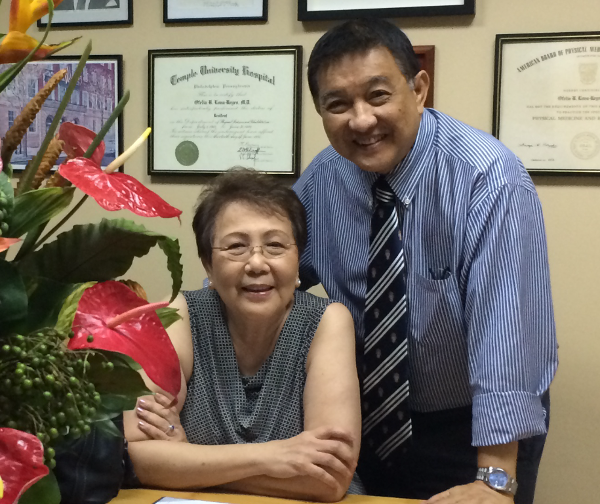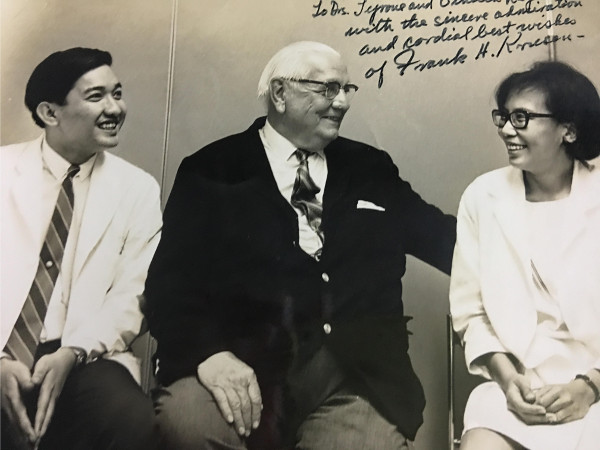
Tyrone Reyes, MD, and Ofelia Reyes, MD, were among the small group that made up the first class of the Temple University Hospital/MossRehab Resident Training Program in Physical Medicine and Rehabilitation. Five decades later, they are returning as keynote speakers for the 50th reunion of the residency program. Dr. Tyrone Reyes recently sat down to answer some questions about the couple’s experiences at MossRehab and the journey they followed after completing the program and returning to their native Philippines.
Let’s go back 50 years to your residency at MossRehab.
Dr. Reyes: It was an exciting time. Back in 1967, my wife and I were residents at MossRehab, and I think we had an outstanding program even then. It involved multiple academic medical centers, of course, with MossRehab as the base, plus Temple University and Albert Einstein Medical Center (today known as Einstein Medical Center Philadelphia). We were exposed to more complex patients with disabilities at MossRehab. At the same time, we had an academic set up at Temple. And Einstein provided an idea of how things were being run in a rehab setting in a general hospital.
We were exposed in MossRehab especially to the different specialties that are involved in rehabilitation – neurology, pulmonary, peripheral vascular disease, rheumatology, pediatrics (which we learned at St. Christopher’s Hospital for Children). It was a unique program in that sense, but also unique in the fact that we really had excellent teachers and rehab doctors. I still think up to now that my wife and I got the best program in the country at that time.
Can you tell us a bit of the background of how you came to MossRehab?
Dr. Reyes: My wife and I came from the Philippines. We graduated from the University of Santo Tomas, which is the oldest medical school in the country. We took our internship at the Mercy Catholic Medical Center, Misericordia in Philadelphia. Before we left the Philippines, three doctors suggested that we specialize in rehabilitation, but we weren’t 100 percent sure. Our chairman at the department of internal medicine, Dr. Gordon French, who was assistant dean of the medical school of the University of Pennsylvania, found himself one day sitting in a plane next to Carl Levenson, the medical director at MossRehab. Apparently, Dr. French said, "Well, I have two young doctors from the facility, who are very much interested in having a residency in rehab." That was the beginning.
Dr. Levenson invited us to go to MossRehab, and we were blown away by the facility, the staff, how they really treated patients. Wow! The first residency group, there were three of us.
In 1971, Ofelia and I decided to stay for one more year. She studied electromyography at Temple. I stayed in MossRehab where I was tasked to establish the first spinal cord injury rehabilitation ward, which I did. After that, we went back home to the Philippines. We have not been back to MossRehab and Temple since then. Although I have seen some of our colleagues, who have visited us here in the Philippines, including some of our co-residents.
In what ways did the residency training prepare you for careers in rehab?
Dr. Reyes: Well, it was very comprehensive training. We were trained well clinically in terms of how to manage patients with different conditions and different disabilities. We were also given a lot of responsibilities; managerial, administrative, especially for me because I was the chief resident. And it was a great training. We were given more responsibilities than I think the regular residents would because there were not as much help from other older residents.

Tyrone and Ofelia Reyes pictured above with Frank H. Krusen, MD, who launched Temple University's Department of Physical Medicine and is considered a key founder of the field of physical medicine and rehabilitation.
Your plan when you returned to the Philippines was to practice physical and rehabilitation medicine. What was the situation that you came back to?
Dr. Reyes: Back then there were very few physicians who were practicing rehab in the Philippines. I think there were only three of them who had some kind of training in the U.S. There were also very few physical, occupational and speech therapists. There was a lack of knowledge about the specialty and the field, and there were very few people who were involved in the field.
So you hatched plans to expand the rehabilitation resources?
Dr. Reyes: We made up a plan that I think we followed quite faithfully throughout. First, we launched a rehab center for clinical care of people with disabilities at the University of Santo Tomas Hospital, which is where we finished our medical school. Very fortunate for us that they gave us some support. I felt at that time that considering the situation here and how new the field was, we first needed to show our colleagues that rehabilitation medicine works. Unless we could show them that, then they would not have the respect that we think we deserved. We established the Apolinario Mabini Rehabilitation Center. Incidentally, Mabini is a Filipino hero who lost the use of his legs due to polio. He was an alumnus of the University of Santo Tomas College of Law.
What came next?
Dr. Reyes: That was a success. After the center, thanks to funding from the World Rehabilitation Fund, we established a residency training program at the University of Santo Tomas Hospital. Just to tell you how successful this program was, we have trained 82 Filipinos, 12 Indonesians and four Chinese in rehabilitation medicine. All have become chairs at major medical schools and centers in the area. For example, the residents from the Indonesia program - according to our last census - have trained about 567 physiatrists - 296 coming from the University of Indonesia alone. They have five training programs, covering all of the five universities in Indonesia. We in the Philippines also now have five training programs. After establishing a residency training program, we started to seed these people in different cities of the Philippines and Indonesia. Next, we established a College of Rehabilitation Sciences to train allied health professionals in rehab; physical therapists, occupational therapists, speech pathologists and so forth. Finally, we set out to teach medical students about rehabilitation medicine. Our idea was not just to train good physiatrists, but also to teach all the students who will become doctors what medical rehabilitation is all about.
You must feel proud to have contributed so much to the field of physiatry.
Dr. Reyes: It's been quite a journey and now in Asia, physical medicine and rehabilitation is quite vibrant at this time. Last year we just had the convention of the Asian Oceania Society of Physical and Rehabilitation Medicine here in the city of Cebu in the Philippines. There have been exchanges in terms of Fellows. We sent some of our residents to Japan, for example, at Keio University. I was there also a number of times to teach the residents at the University of Tokyo. We have been active with the Philippine Foundation for the Rehabilitation of the Disabled and helped enact a law that covers all aspects of the care of people with disabilities. My wife, Ofelia, also founded the pediatric rehabilitation fund, which has been assisting children with disabilities who are unable to pay for their treatments or need some kind of special care.
What lies ahead for you?
Dr. Reyes: Ofelia and myself are about to retire. I'm turning 75 in June. Ofelia's turning 75 in July. But still we're working part time. We still love to work.
Looking back over these past 50 years what are a couple of the things that stand out to you in terms of how physiatry has changed?
Dr. Reyes: There's no question that there has been significant changes, of course. The specialty now is well recognized, well accepted, even here in a developing country, both academically and clinically. You can see that from the way our colleagues in the medical field treat us because they have seen the significant value to their patients. There has been also a broadening in the scope of the practice of rehab doctors, including here in the Philippines. Now, the staff do EMG testing, bone mineral density testing, musculoskeletal ultrasound testing. We're not only involved in terms of treatment, but we are involved in terms of diagnosis, in doing diagnostic tests.
In terms of technology, prosthetics and orthotics have improved significantly here. A few hospitals have started to employ robotics in the treatment of patients with strokes or other neurological conditions. I also have seen a lot more involvement of physiatrists in interventional treatment in musculoskeletal conditions. There is now more involvement in exercise medicine. A lot of physiatrists here in the Philippines are involved in sports medicine, as well. The future is bright. In Asia and Southeast Asia, in the Philippines in particular, we have a lot of applicants for residency training programs. The schools are having more applicants in the allied rehabilitation sciences courses that they offer at the university, and it's attracting young talented people in to the field. This is something that is quite positive for the future of the specialty.
You're going to present at the reunion. What do you plan to talk about?
Dr. Reyes: We plan to tell the story I have just been sharing, about our journey from the residency at MossRehab to where we are today and the challenges we have faced.
Have your children gone into medicine as well?
Dr. Reyes: We have five children. Three are physicians. All went to Haverford College. One is an orthopedic surgeon specializing in total joint replacement surgery. He trained at the University of Pennsylvania. Another trained at Johns Hopkins and is now an interventional radiologist. A third went to Penn State and is now a physiatrist at the University of Washington in Seattle. We have six grandchildren.
Are you excited about the reunion?
Dr. Reyes: I'm really looking forward to seeing our colleagues, who I hope will all be there.
Do you have a message for those who have not decided if they are coming to the reunion?
Dr. Reyes. This is going to be a very significant event not only for MossRehab, but for the people who have made MossRehab what it is today. I think that we should all show support for the institution that gave us all the opportunity to be able to work in the field of medical rehabilitation. My wife and I owe MossRehab a lot. It gave us a lot of confidence. We gained a lot of knowledge, the right attitude and the skills that were necessary to help our countrymen here in the Philippines and also other countries in Asia, including especially Indonesia and China. I hope that all of the MossRehab residency alumni come. It's a once in a lifetime kind of event. All of the alumni should go back and reminisce and express their gratitude to the institution for what we have become.
Learn more and register for the 50th reunion celebration